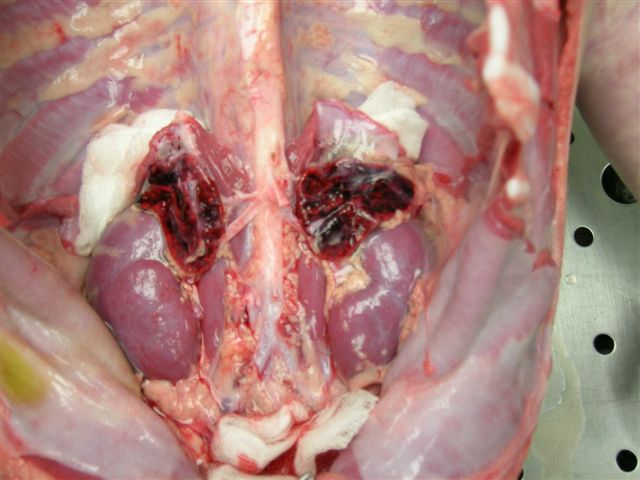Table of Contents
Definition / general | Clinical features | Case reports | Treatment | Gross description | Gross images | Microscopic (histologic) description | Differential diagnosisCite this page: Pernick N. Waterhouse-Friderichsen syndrome. PathologyOutlines.com website. https://www.pathologyoutlines.com/topic/adrenalWFsyndrome.html. Accessed April 19th, 2024.
Definition / general
- Hemorrhagic necrosis of adrenal glands, usually due to bacteremia, classically Neisseria meningitides; also Pseudomonas aeruginosa, pneumococci, staphylococcus and historically Haemophilus influenzae
- Less common causes are burns, cardiac failure, hypothermia and birth trauma
Clinical features
- More common in children, particularly before age 2 years
- Usually bilateral; newborns may have unilateral hemorrhage, more commonly in right adrenal gland
- Symptoms: shock, disseminated intravascular coagulation and adrenal insufficiency; the shock may cause the hemorrhage
- Meningococcemia (Arch Pathol Lab Med 1977;101:6)
Case reports
- Newborn boy with Echovirus type 6 infection, otherwise healthy (Mod Pathol 2001;14:85)
- 47 year old woman with Capnocytophaga canimorsus septicemia (Arch Pathol Lab Med 2000;124:859)
Treatment
- Treat underlying infection with antibiotics
- Also cortisol, electrolytes
- Must detect and treat quickly
Gross description
- Glands are enlarged and hemorrhagic with extensive cortical and medullary necrosis
Gross images
Microscopic (histologic) description
- Hemorrhage, necrosis, fibrin deposition, neutrophilic infiltration of medulla and cortex
- Zona glomerulosa cells may be spared
Differential diagnosis
- Central adrenal vein thrombosis





